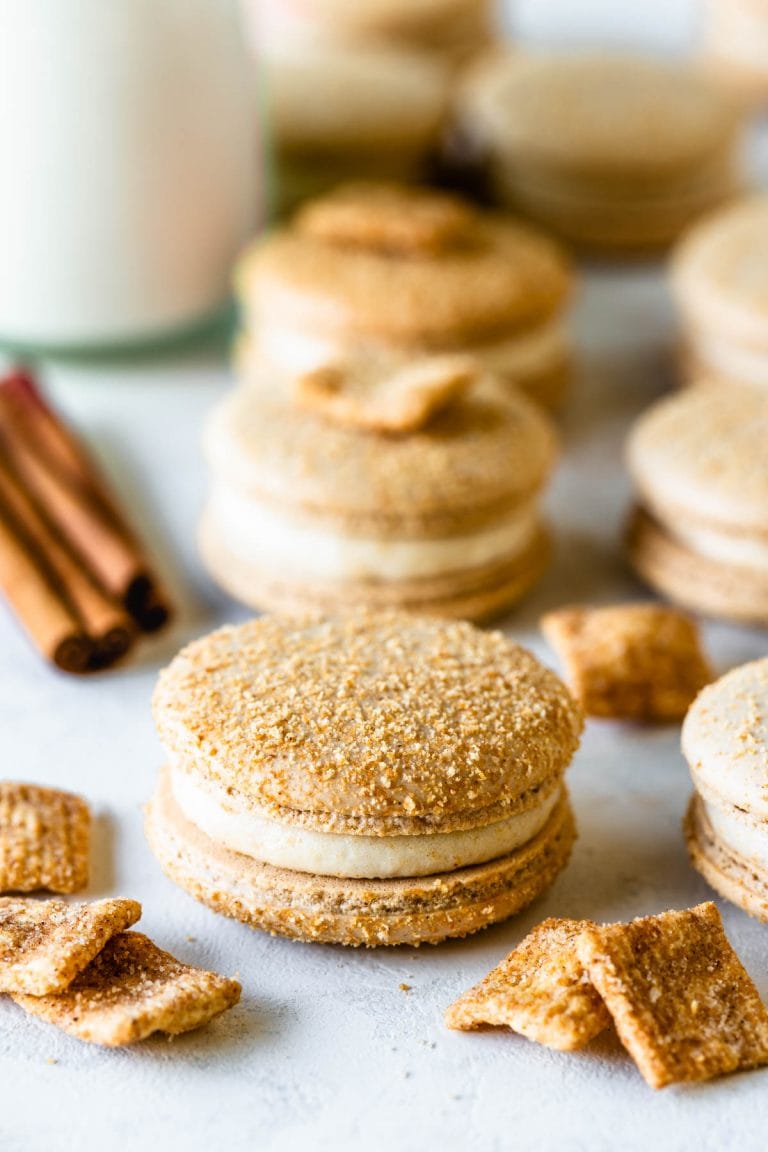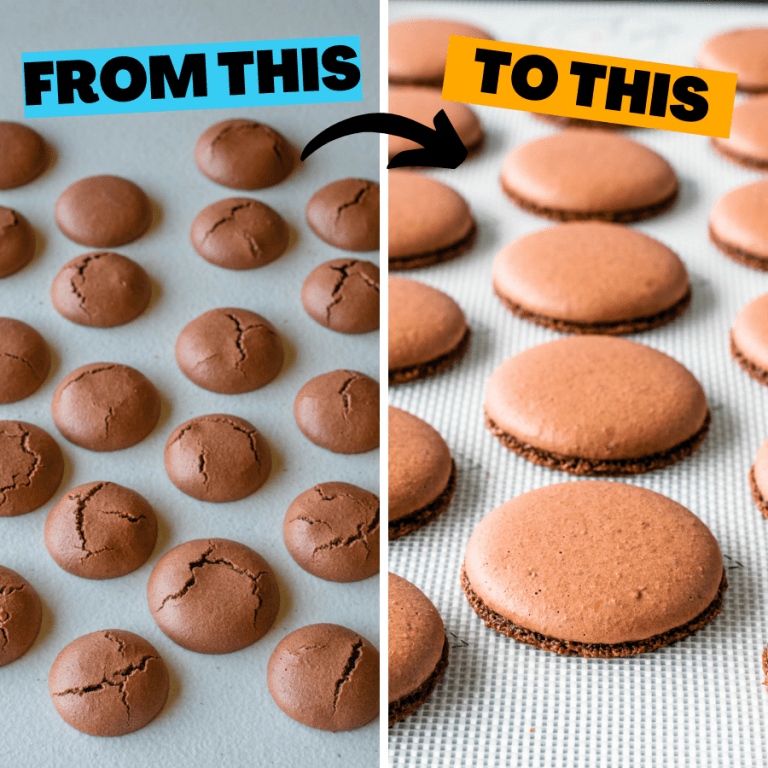Coconut Fudge Macarons
Hello friends! Let’s make some Coconut Fudge Macarons. These macarons are filled with a coconut fudge that is shelf stable for a couple of days, and it is so delicious and creamy! It won’t melt during the heat, and will hold very well. It’s also super easy to make.
Make sure to watch the video on this page or on YouTube where I show exactly how I made these Coconut Fudge Macarons.

These Coconut Fudge Macarons were the first batch I made on my new house and new oven! It was quite a learning experience.
This post may contain affiliate links. I earn a commission from qualified purchases. Please read our Privacy policy here.
I live in a much more humid climate now, and my oven is completely different than my previous one.
I have already talked about all the differences and the adjustments I’ve been having to make to be able to achieve successful macarons, specially on my Instagram stories, and also here on this Harry Potter Sorting House Macarons post, where I disclose every step I’ve been taking lately.
Basically, my oven is absolutely terrible at keeping a constant temperature. So to minimize that, I’ve taken some measures, and they are as follows:
- Place pizza stones on the bottom rack of the oven. The pizza stones will act as a radiator, because they will absorb a lot of heat and when you open the oven door, the pizza stones will radiate heat, which will help keep the temperature stable in case your oven fluctuate the temperatures a lot like the one I am using.
- Pre-heat the oven for a long time (1 hour+, with the pizza stone inside). This will also help keep the temperature fluctuation at bay, since the oven will have a chance to spike up and down until it finds a happy medium.
- Use rimless baking sheets like this one. You may see me piping on a regular baking tray with the tall rims, but I am not using them to bake, I transfer the mat to a rimless sheet before baking. I only have two of them right now so I have to pipe the shells on another surface while they rest. Remember to only place macarons on top of room temperature baking sheets, not hot. If you just removed the baking sheet from the oven, wait for it to cool down before transferring your mat to it, because your macarons will most likely crack if you use a hot or warm baking tray to bake the macarons. Additionally, the rimless baking sheet allows for the air to circulate evenly throughout the shells, which means even heat is reaching the shells, which will minimize hot spots issues, and results like lopsided or cracked macarons.
- Rest the macarons. The no-rest method hasn’t been working on my inconsistent oven. The macarons have cracked, or the ones that didn’t crack had the a weird crack between the top of the shell and the feet. The cracks only went away once I started resting the macarons fully, which can take over an hour in my current humid climate.

Also recently I’ve purchased a dehumidifier to help control the humidity in my baking space, which has helped tremendously with drying time.
And I have also purchased a little countertop oven. It is small, so you can only bake quarter sheets in there, but with the mini oven, I don’t have to rest the macarons.
So I am baking the macarons straight in the small oven after piping, and while they bake, I pipe the ones that will be resting to be baked in the large oven, so it all works. And it’s actually speeding up the macaron baking process a lot!

The coconut fudge used to fill the macarons is actually a coconut brigadeiro (as known as beijinho in my home country Brazil). Beijinho means little kiss in Portuguese.
Brigadeiros are sweetened condensed milk fudge cooked on the stove top with butter and flavoring. We usually eat it as a truffle, rolled in sprinkles or chopped nuts, shredded coconut, etc. But it can also be used to fill cakes, cupcakes, and even as frosting. So of course I would want to use it to fill macarons.
Brigadeiros are extremely easy to make, but can be tricky to get to the right consistency. If you cook it too much, it becomes too thick, and if you don’t cook it enough it will be too runny and soft.
However, once you master the consistency, this might become one of your favorite fillings. It is shelf stable for a couple of days, it’s resilient in the heat, so it won’t melt immediately like a butter based frosting would, and best of all, it’s absolutely delicious, you will seriously want to eat the whole entire pan with a spoon.
Ps. I have a list of brigadeiro flavors you could use to fill macarons:
- Brigadeiro (traditional chocolate)
- Beijinho (coconut-today’s flavor, but the link will show you how to make them into truffles)
- Caramel
- White Chocolate Strawberry
- Dulce de Leche
- Nutella
- Key Lime
And also check out these macaron recipes:
- Brigadeiro Macarons (filled with chocolate fudge)
- Toffee Macarons (filled with caramel fudge)
- German Chocolate Macarons (filled with the same coconut fudge)
Needless to say how much I absolutely love this sweetened condensed milk fudge for macarons! It’s the perfect type of filling.

If you are learning how to make macarons, check out my page Macaron School. It has all the resources you need to learn how to make macarons: troubleshooting guides, guides for beginners, understanding your oven, the science behind macarons, my favorite tools, and more!

Oh, and also, I used the Coconut Fudge Macarons to decorate my birthday cake! Check it out!
I have a short video showing the decoration here.


Coconut Fudge Macarons
Ingredients
Macaron Shells
- 100 grams egg whites
- 100 grams white granulated sugar
- 105 grams almond flour
- 105 grams powdered sugar
- Food coloring read notes
Coconut Fudge
- 1 can sweetened condensed milk 14 oz, 396 grams
- 1/2 cup shredded coconut can be sweetened or unsweetened
- 1 tbsp butter
To roll
- 1 cup shredded coconut
Instructions
Macaron Shells
- Before you start, get all of the ingredients ready. Prepare a large piping bag, fitted with a large round tip, I use a 1/2” diameter tip. Set aside.
- Line two baking sheets with parchment paper or silicone mat.
- I use a baking mat with the macaron template already in it.
- Measure out all of the ingredients.
- Sift the powdered sugar and almond flour together. Set it aside.
- Place a bowl over a pan with barely simmering water. Add the sugar and egg white powder to the bowl if using. If you’re not using egg white powder simply skip it.
- Whisk the sugar and egg white powder so it doesn’t clump up.
- Add the egg whites to the bowl and whisk until the sugar is completely melted. It will take a couple of minutes. You can test by touching the mixture between your fingers, and if you feel any sugar granules just keep whisking the mixture over the water bath.
- Make sure the bottom of the bowl isn’t touching the simmering water because you don’t want the whites to cook.
- Also, don’t overheat the sugar syrup, this may cause issues down the line, such as wrinkly macarons.Transfer the syrup to the bowl of a stand mixer.
- With the whisk attachment, start whisking mixture on low for about 30 seconds, then gradually start increasing speed to medium. Whisk on medium for one to two minutes, until the mixture is white and starting to become fluffy. Raise the speed to medium or medium-high and whip for a few minutes until stiff peaks are formed.
- To know if the meringue is done whipping , keep your eye on the whites. Once they get glossy and you start seeing streaks formed by the whisk, and the meringue raising in the center of the whisk, it might be time to stop.
- You don’t want to overbeat the mixture at this point, because you don’t want to add too much air to it. Just whisk until stiff peaks have formed.
- Whisk until stiff peaks have formed. When you pull your whip up, the peak should be stiff and shooting straight up, with possibly a slight bend at the top, but not bending to the side.
- Pour the sifted powdered sugar and almond flour into the stiff meringue.
- Start folding gently forming a letter J with a spatula.
- Add the food coloring at this point, if using. For all the macarons shown here, I've used different colors which I've disclosed down below in the notes. The different colors were made from different batches when I was testing my new oven in my new house.
- After adding the food coloring continue to fold the batter, incorporating the ingredients and then squeezing the air out by pressing the batter down along the sides of the bowl as you stir.
- How to know when to stop folding the batter: It’s time to stop folding when the batter is glossy and has a thick and flowing consistency. There are several ways to test this.
- First, pick up some batter with the spatula and try to draw a figure 8 with the batter that is dripping off the spatula. If you can form several 8 figures without the batter breaking up, that’s one indication that it might be ready.
- There’s another test you can do. I call it the Teaspoon test. Grab a teaspoon of batter and spoon onto the parchment paper or silicon mat. Wait a minute to see how it behaves.
- If the batter stays stiff, forming a point and doesn’t spread out, fold a little bit more, about 3 folds.
- Test again.
- You don’t want your batter to be too runny either. So be careful not to over mix. It’s always best to under mix and test several times until the proper consistency has been achieved.
- When you hold the spatula with batter on top of the bowl and the batter falls off the spatula slowly but effortlessly the batter is ready. The batter will keep flowing off the spatula non-stop, but not too quickly.
- Once the batter spreads out a bit and starts to look glossy and smooth on top, on the parchment paper, it’s ready.
- Transfer the batter to the piping bag.
- Place the piping bag directly 90 degrees over the center of each macaron template. Apply gentle pressure and carefully pipe for about 3 seconds, and then quickly pull the bag up twisting slightly.
- Once you’ve piped as many circles as you could, bang the trays against the counter a few times each.
- Use a toothpick to pop any air bubbles in the surface of the shells.
- Let the trays sit for a while so the shells will dry out a little bit. I usually leave about 20-40 minutes, depending on how humid the day is. You’ll know they’re ready when you gently touch the surface of a macaron and it seems dry.
- I baked mine at a 315 Fahrenheit oven for about 20 minutes. I pre-heated my oven for about 1 hour before starting, and I also have a pizza stone on the bottom rack of my oven in an attempt to control temperature fluctuations. I have been baking my macarons on a rimless baking sheet for best results and better air circulation, to help the macarons bake evenly.
- Bake one tray at a time.
- Bake for 5 minutes, rotate the tray in the oven to bake evenly on all sides. And then continue baking.
- I bake each tray for about 15 to 20 minutes, rotating after the first five minutes baking. This means to simply turn the tray around in the oven 180 degrees, so it’s making sure the heat is distributed evenly since the back and the front of the oven often have different temperatures. The smaller macarons were baked for about 13 minutes.
- When baked, the macarons will have a deeper color and formed feet. If you try to move a macaron, it shouldn’t feel jiggly. If the macaron is still jiggly, keep baking.
- Remove from the oven and bake the other tray.
- Let the macarons cool down before proceeding with the filling.
Coconut Fudge
- Mix all ingredients: condensed milk, 1/2 cup shredded coconut, and butter in a medium saucepan.
- Over medium heat, stir the mixture without stopping, while you bring it to a boil.
- Once the mixture comes to a boil, reduce heat to medium low.
- Keep stirring non stop while it cooks.
- Don’t stop stirring the mixture, or the fudge will stick to the bottom of the pan.
- You should cook it for about 10 to 15 minutes. The longer you cook, the thicker it will become.
- To test if the fudge is ready, simply tilt the pan and if the mixture comes off from the bottom of the pan, you’re good to go. The fudge will look shiny and firm, it will drop in chunks from the spatula and not in a ribbon. If you run a spatula on the bottom of the pan, fudge will take about 5 seconds to come together again. You are looking for a very thick stage, but be careful not to overcook it, if you do overcook it, it will be impossible to pipe it on the macarons.
- Remove the fudge to a buttered plate and let it cool down to room temperature. Don’t place it in the fridge or it will become too hard. The fudge can stay at room temperature for one to two days.
To assemble
- Place the cooled down fudge in a piping bag fitted with a round tip. Pipe it on each bottom shell and then top with another shell. The fudge is very thick, so might be tricky to pipe. Be patient and grab the piping bag closer to the tip to be able to apply more pressure and have more leverage to make the filling come out. However, if you do notice it is too hard to pipe, it’s because it’s been overcooked. If the fudge is overcooked, there’s nothing that can be done to soften it, you can eat it with a spoon if you wish.
- After piping the fudge on the shells, place a shell on top. Then roll the sides of the macaron in the shredded coconut, you can help the coconut stick to the fudge by sprinkling it on top.
Storage
- These macarons will survive at room temperature for one to two days, because of the nature of the filling.
- Still try to store it in the fridge instead of leaving it at room temperature if possible. They will last much longer.
- Shelf life in the fridge should be about 4 to 5 days, and 1 to 2 months in the freezer, in an air tight container.









O visual e sabor são fantásticos!!!!!
Best macaron filling ever!! It’s easy and so delicious.
Thank you Debbie!!!
These are delightful! The coconut fudge is a little tricky to pipe, but the results are definitely worth it.